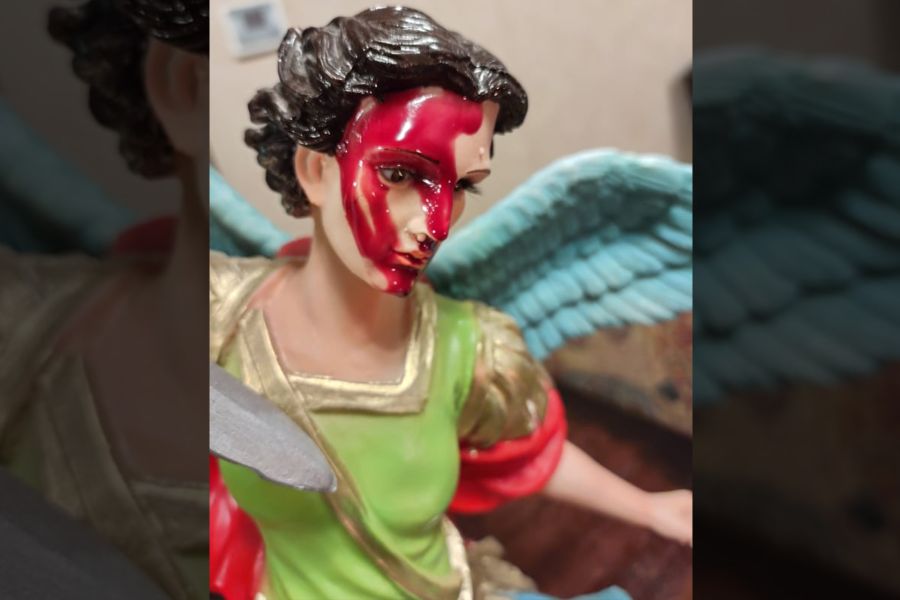Remembering the Revolution of Denver’s World Youth Day 1993
25 years later, transformative event is still bearing fruit, as new initiative aims to further the dynamism.

“No water bottle, no camera, no sunscreen and no rain jacket. That’s how I showed up for the first day of World Youth Day 1993.”
So recalled Father Randy Dollins, vicar general for the Denver Archdiocese, speaking to laity and clergy gathered Aug. 11 at the “More Than You Realize” conference marking the 25th anniversary of St. John Paul II’s visit to the Mile High City.
The then-17-year-old Dollins was an hour late arriving to his parish, and the bus with his fellow pilgrims had already left for the opening of the five-day international youth celebration, which was the first, and as yet only, held in the United States.
“When I checked in with my youth minister, he didn’t think [my tardiness] was that big a deal,” Father Dollins said. “He gave me my World Youth Day badge. He walked me out to the parking lot … onto a bus full of 40 young men from Spain. Four of these guys spoke English. He told them I was going to be their local guide.
“And so began one of the greatest adventures of my life.”
Father Dollins credits WYD 1993 with his vocation to the priesthood.
“[It] changed me on a fundamental level,” he said. “The path from that event to where I stand now … is something I never could have imagined; it’s way more than I ever could have realized.”
Indeed, WYD 1993 was far more than anyone had realized.
It is credited with igniting a spiritual dynamism in the Denver Archdiocese that led to numerous vocations to holy orders and consecrated life; the establishment of not one, but two, seminaries packed with men studying for the priesthood; the founding of a plethora of energetic apostolates; and vibrant charisms and movements dedicated to advancing the New Evangelization.
It launched the New Evangelization not only in Denver, asserts St. John Paul II biographer George Weigel, but across the United States.
And St. John Paul II himself exuberantly called Denver’s World Youth Day “a revolution.”
Twenty-five years later, the Denver Archdiocese remains centered on the New Evangelization. The archdiocese used the anniversary conference held Aug. 11 at the Budweiser Event Center in Loveland, Colorado, to celebrate what happened and to launch an initiative to carry the continuing momentum into the future.
The bilingual event drew 5,000 people who had been invited from the archdiocese’s 148 parishes.
Looking Back
In 1992, Denver and two other U.S. cities — Buffalo, New York, and St. Paul, Minnesota, both boasting higher Catholic populations — were being considered to host the youth event.
Located just minutes from the Rocky Mountains, Denver was known for its natural beauty and as a technology and communications hub, said WYD ’93 attendee Edward Sri, a vice president for Fellowship of Catholic University Students and an Augustine Institute professor.
People consequently were shocked when, on Palm Sunday 1992, it was announced the Pope had selected Denver.
“It’s more of a modern, self-consciously secular city,” Sri told conference attendees, adding that previous youth days were held at traditional pilgrimage sites like Czestochowa, Poland.
“The idea for John Paul II was clear: He wanted to bring the Gospel to the secular city … to proclaim the Gospel there, to show the Gospel still has relevance for modern men and women.”
Journalists, noting the “cafeteria Catholicism” of many Americans and the Holy Father’s age, 73, and even some American bishops were skeptical it would amount to anything. The only ones expected to show up were those protesting Church teaching. Making matters worse, in 1993, Denver was experiencing terrifying drive-by shootings, which led media to call it “the summer of violence.”
“Everybody thought [the Pope] would fail. I remember being here as a young person seeing the news crews; they were ready to film an abysmal failure, an embarrassment,” Real Life Catholic founder Chris Stefanick told his audience at the anniversary event. “They were blown away. Three-quarters of a million people came.”
The final papal Mass, celebrated Aug. 15, the Solemnity of the Assumption of Mary, at Cherry Creek State Park, drew people from 70 nations.
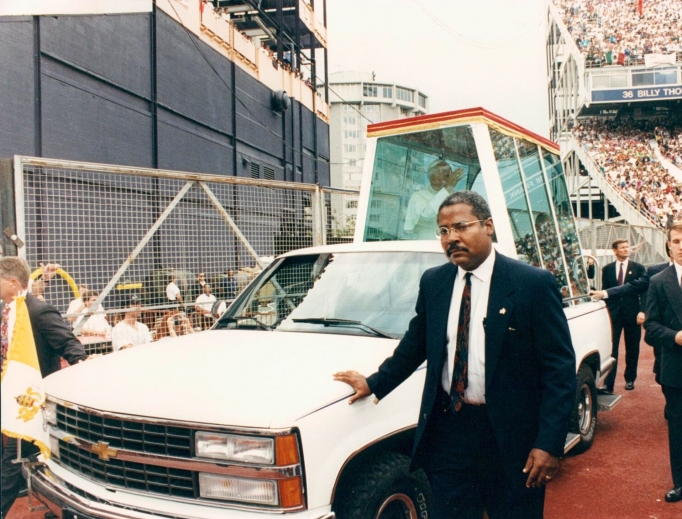
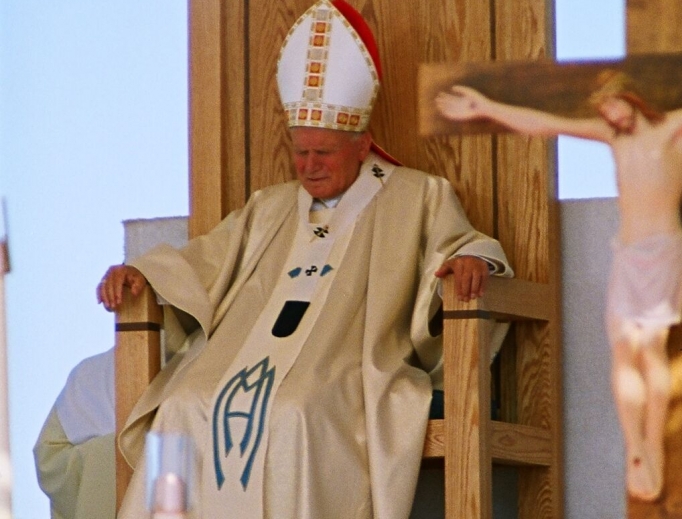
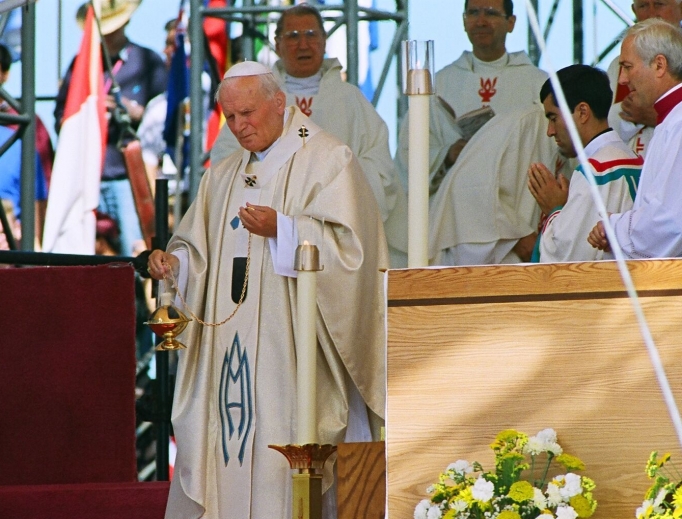
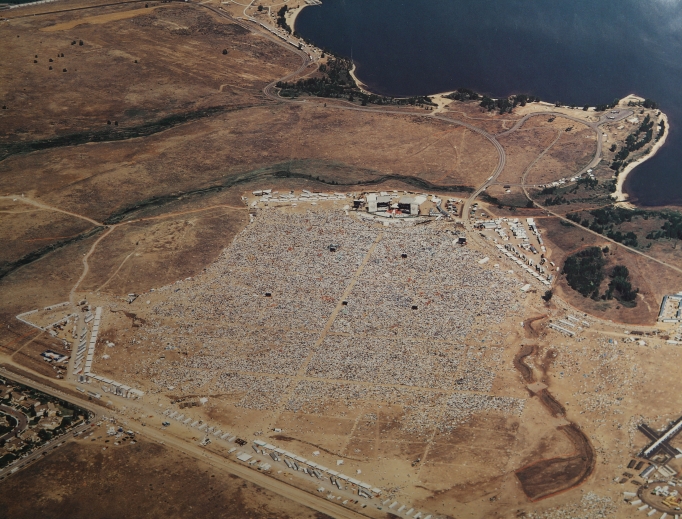
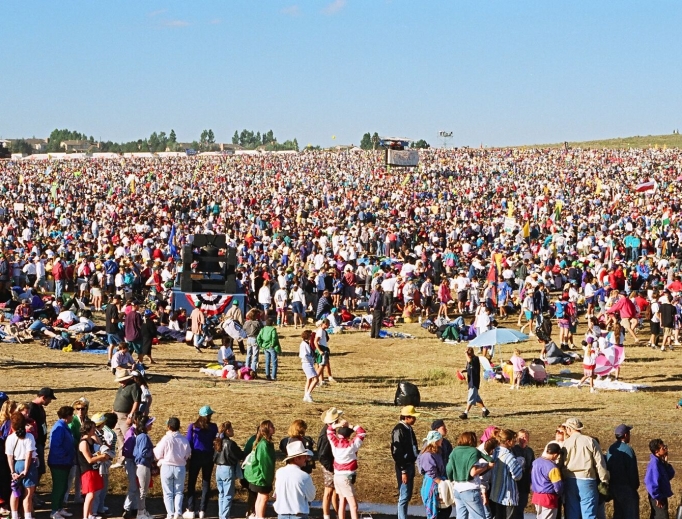
The presence of the Holy Spirit was palpable in the joy of the attendees and the peace that descended on the city.
“There was a record amount of gang violence [that summer], and I remember the violence going down to zero — there was no crime during World Youth Day,” Stefanick recalled. “Absolutely mind-blowing.”
“More [important] than numbers or a big statement in history, there were conversions. Because in the eyes of God, one soul is worth more than anything,” Stefanick said before reading a journal entry from a WYD 1993 attendee who had lost her faith in college.
“During the Pope’s talks, I felt a bond with Jesus that I never have before,” she wrote. “I believed everything once again: that Jesus is the Son of God, the Savior of the world who loves me … and gives life eternal.”
“The atheist convert who wrote that married me five years later,” Stefanick said. “Saints change history. Saints change lives. It’s not just the message of the saints — it’s who they are.
“[St. John Paul II] came to remind us who God is and who we are. And he came to send us to be reminders to the world of who God is and who we are.”
The Fruits
Scott Elmer, executive director of Evangelization and Family Life Ministries for the Denver Archdiocese, calls himself a “second-generation fruit” of WYD 1993.
“I had two priests that evangelized me and proclaimed Christ boldly while I was at college at a Newman Center. Both of them were here in ’93 and told me the atmosphere was electric. It influenced them to become priests,” he said at the anniversary event.
Discipled by Fellowship of Catholic University Students while an undergrad, Elmer then attended Denver’s Augustine Institute. Both ministries were born as a result of WYD 1993.
The women’s ministry Endow (Educating on the Nature and Dignity of Women) came to be after co-founder Terry Polakovic hosted four students from France who attended Denver’s WYD.
“It was through hospitality that she realized how much she loved John Paul II and his teaching on women, marriage and family,” Elmer said.
Other apostolates tied to Denver’s WYD include the Centro San Juan Diego for Spanish-speaking Catholics, Stefanick’s Real Life Catholic, and Christ in the City homeless ministry.
WYD 1993 also drew new charisms and lay movements to Denver and helped existing ones to flourish.
“A ton have sprung up since 1993: Christian Life Movement, Christian Family Movement, Neocatechumenal Way, Communion and Liberation, Catholic Charismatic Renewal,” Elmer said, listing some. “[They’re] reaching thousands of Catholics, helping people to encounter Christ and to live as disciples.”
Today’s Challenges
Despite the abundant fruits from Denver’s World Youth Day, the U.S. Church is facing an increasingly secular and anti-Christian society, Elmer said.
Citing statistics from the Center for Applied Research in the Apostolate at Georgetown University, he said that, since 1970, although the Catholic population has increased by 21 million people, there are about 22,000 fewer priests serving them. Additionally, the number of former Catholics has quadrupled to 30 million people, infant baptisms are down by a half-million, marriages are down by two-thirds, and Mass attendance is half of what it once was.
“If we’re not aware of the reality that souls are being lost to the Church, we’re not going to be appropriately responding to this crisis,” he said. “In the midst of this, we live in a secular area. Denver is a very secular city. And Colorado itself is very politically progressive in [issues] that are against Church teaching.”
Colorado was among the first states to legalize the recreational use of marijuana (2012). In 2014, it legalized same-sex “marriage.” In 2016, it legalized physician-assisted suicide.
Worst of all? The renewal of the sex-abuse scandal in the United States as a result of “credible and substantiated” allegations against Archbishop Theodore McCarrick, former head of the Washington Archdiocese, and other related scandals, including the grand jury report in Pennsylvania released this week.
“This is heinous,” Elmer said. “Internally, [it] challenges our faith in the institution. Externally, it doesn’t seem like we have moral authority.”
Among the good news? Forty-eight percent of today’s Catholics have never left the Church, and 11% once left but returned.
Best of all? “We have problems and challenges,” Elmer said. “We also have Jesus, so that’s a good thing.”
“[St. John Paul II] didn’t go to a holy place; he came to a war zone. He came to a place that needed the truth,” Elmer said. “He gave us that mission. Now is the moment when this mission is being handed on to your generation: to preach the Gospel.”
Looking Forward
In a video shown at the conference, Joshua Karabinos, chief strategy officer for the Denver Archdiocese, said that despite the recent proliferation of quality catechetical content and the personal witness of authentic Catholic Christians, people formed in our postmodern culture aren’t interested in “answers to questions they haven’t asked.”
“Our efforts are left resounding in an echo chamber of like-minded Catholics who already seek to understand the faith,” he said. “Perhaps the problem we face … is a problem of real encounter in relationship-building.
“Catechesis was never meant to be the primary bridge from irrelevance to curiosity. Church documents call that bridge pre-evangelization. This is the first key to missionary discipleship.”
To equip the faithful in the effort of pre-evangelization, the archdiocese launched the More Than You Realize initiative at the conference. It consists of a website, MoreThanYouRealize.org, that offers engaging, shareable videos.
It will eventually include other content that isn’t overtly religious, Father Dollins said, but which is focused on sharing truth, beauty and the good as curiosity builders and conversation starters.
Content will include speakers exploring thought-provoking topics, will model how to enter into or lead discussions related to such topics, and will offer the ability to join small groups for training and discussion.
The initiative’s logo is an eye chart, with the R turned backward to be an attention grabber, and to highlight the initiative’s aim — to have people refocus on the Catholic faith. Although launched at the conference, the archdiocese plans to spread the effort throughout the archdiocese.
“It’s time for a new movement. It’s time for a new way of being the Catholic Church,” Father Dollins told the audience. “It’s time to get out of the ‘Upper Room’ and into the streets of our Jerusalems and start telling people about Jesus Christ and creating authentic curiosity that will draw [people] deeper into the meaning of what they were actually created to be.”
Sri imparted tips on how to be a missionary disciple, urging the faithful to ongoing interior conversion; to accompany others through authentic friendship and sharing one’s testimony; and to foster the faith of others in small but deep ways.
Father Dollins outlined four pillars to help those in ministry, urging his audience to reflect on how hospitably they receive others, how to free up clergy and employees to do the things they do best, how to form oneself and others to be missionary disciples, and on how to go out to share the Gospel.
“When I went to World Youth Day, I got caught up in a movement,” Father Dollins said. “I was a secular kid. The thing that was compelling to me about the Church was the witness of the people and their passion for the faith.
“We need to go out in such a way that we create holy envy and holy curiosity in other people.”
Sent Forth
The conference ended with a Mass during which Denver Archbishop Samuel Aquila commissioned conference attendees to be missionary disciples.
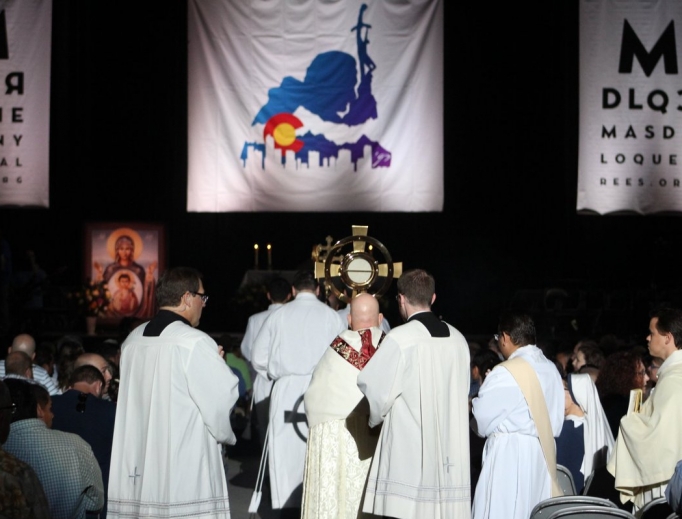
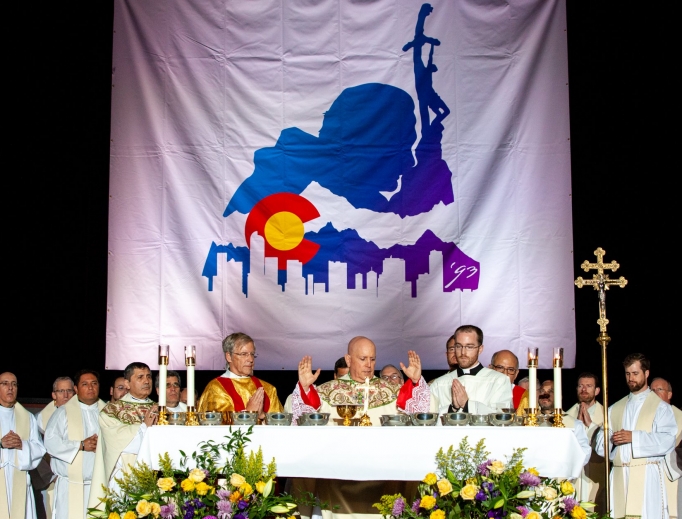
“The journey of discipleship is a lifelong journey,” Archbishop Aquila said. “I, as your bishop, am counting on you … to help establish a culture of discipleship in our local Church.
“St. John Paul II believed in retrospect that a revolution had taken place in Denver. We today are the inheritors of this spiritual revolution, and we must not be afraid to let our nets down for a catch. … Your role in the plan of God is much more than you realize.”
Cardinal J. Francis Stafford, who served as Denver’s archbishop during WYD 1993, addressed the crowd just before the Mass.
“In October 1993, a few months after World Youth Day, I visited the Vatican. … When it came my time to be greeted by [St. John Paul II], he said without any hesitation, ‘Ahh, Denver, Denver — una rivoluzione!’ (Ahh, Denver, Denver, a revolution!)
“What we are doing today, dear brothers and sisters, in the commissioning … is to continue that revolution.”
Roxanne King writes from Denver.








